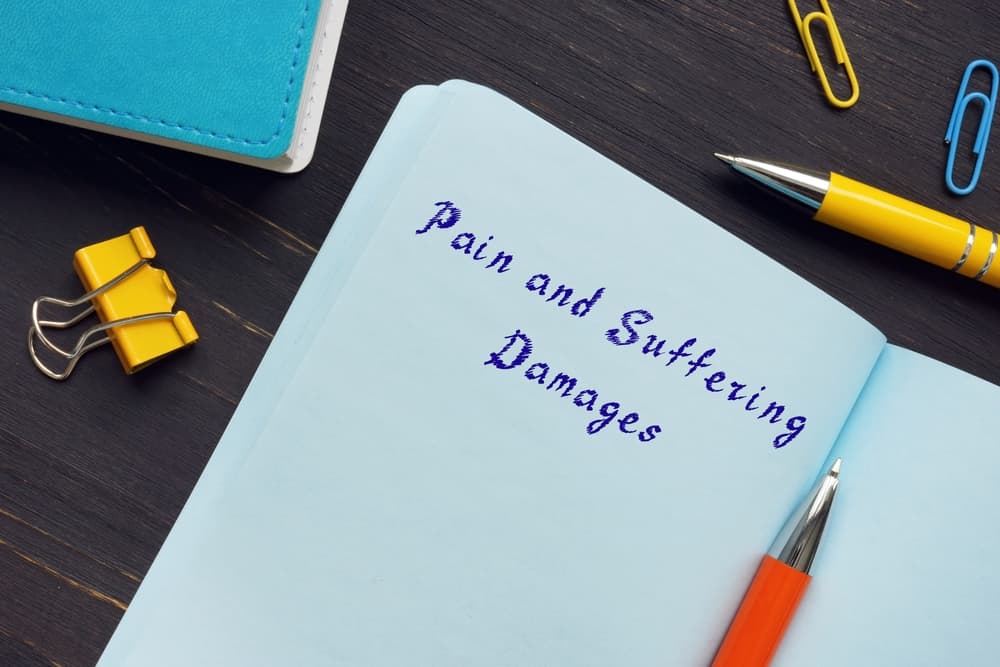Motorcycle accidents can have life-changing consequences. They often result in devastating physical injuries and emotional trauma. For victims, the aftermath is not just about recovering from physical harm but also dealing with the mental and emotional toll. Pain and suffering damages aim to address these less tangible losses, serving as a form of compensation for the victim’s ordeal. Consulting with an experienced motorcycle accidents lawyer can help you navigate the complexities of claiming these damages.
But how much is pain and suffering worth for a motorcycle accident? The answer depends on several factors, from the severity of your injuries to the extent of your emotional distress. Below is a break down of what pain and suffering damages include, how they’re evaluated, and how you can protect your rights to seek fair compensation.
For a free legal consultation, call 516-451-7900
What Are Pain and Suffering Damages?

Pain and suffering refer to the physical and emotional hardships experienced after an accident. Unlike medical bills or lost wages that have clear dollar amounts, pain and suffering damages are subjective and depend on individual circumstances.
These damages include:
- Physical pain from injuries, surgeries, or ongoing medical conditions.
- Mental anguish such as anxiety, depression, or PTSD.
- Loss of enjoyment of life, if the injuries have reduced your ability to engage in hobbies, social activities, or even basic daily tasks.
- Disfigurement or permanent scarring.
For motorcycle accident victims, the nature of the injuries often means that these types of damages can be extensive.
Motorcycles lack the protective barriers of a car, which leaves riders particularly vulnerable during collisions. This vulnerability frequently results in severe or catastrophic injuries that cause long-term suffering.
Examples of Pain and Suffering After a Motorcycle Accident
To better understand what pain and suffering encompass, consider these scenarios:
- A motorcyclist suffers multiple fractures and nerve damage in an accident. Although they undergo surgery and months of physical therapy, they never regain full mobility in their leg. This limitation causes chronic pain and prevents them from continuing hobbies like hiking and cycling, leaving them emotionally devastated.
- A rider is hit by a distracted driver and suffers third-degree burns over a large portion of their body. Long after the physical scars heal, they struggle with depression and social anxiety due to visible disfigurement.
- A motorcycle collision results in traumatic brain injury. The victim loses cognitive abilities, affecting their relationships, career, and self-esteem. Even after visible wounds heal, they face ongoing emotional challenges and require therapy.
These examples demonstrate how pain and suffering damages go beyond the physical injuries themselves. They address the deeper, intangible losses victims endure.
How Are Pain and Suffering Damages Calculated?
Calculating pain and suffering can be one of the most complex parts of a personal injury case. There’s no universal formula, and insurance companies, judges, and juries may each approach the process differently. Nevertheless, there are a few common methods utilized by insurance companies and factors that influence the final amount awarded.
The Multiplier Method
One of the most frequently used methods by insurance companies is the multiplier approach. Here’s how it works:
- The victim’s economic damages, such as medical expenses and lost income, are calculated.
- These damages are multiplied by a number (typically between 1.5 and 5), depending on the severity of the injuries and suffering..
The Per Diem Method
The per diem method assigns a specific dollar amount to each day the victim suffers, from the date of the accident to the date they reach maximum medical improvement..
Settlements vs. Jury Awards
Insurance companies often calculate pain and suffering damages during settlement negotiations. However, if the case goes to trial, a jury will assess the evidence and decide on an appropriate amount. Juries may be more subjective in their assessments and sometimes award higher amounts for severe cases.
It’s crucial to remember that no method guarantees a specific payout. Every case is unique, which is why legal guidance plays an essential role in advocating for a fair value.
Factors That Influence Pain and Suffering Damages
Several factors determine the final amount awarded for pain and suffering. These include:
1. Severity and Type of Injuries
The more severe and long-lasting your injuries, the higher the potential compensation for pain and suffering. For example:
- Soft tissue injuries like sprains or strains generally result in lower awards.
- Catastrophic injuries such as spinal cord damage or amputation often lead to substantial compensation due to the profound impact on the victim’s life.
2. Duration of Recovery
Recovery time is another critical factor. Temporary injuries that heal within weeks may warrant lesser damages, while chronic conditions or lifelong impairments justify greater amounts.
3. Impact on Daily Life
The extent to which your injuries disrupt your ability to work, enjoy life, and maintain relationships is a major consideration. A young athlete who loses mobility in their legs, for example, is likely to receive more than someone of advanced age with a similar injury.
4. Documented Evidence
Strong evidence is key to proving the full extent of your pain and suffering. Documentation can include:
- Medical reports detailing the severity of your injuries.
- Testimony from doctors or therapists about your physical and emotional condition.
5. Credibility
Your credibility as a plaintiff can also affect the outcome. A consistent account of your suffering, backed by tangible evidence, will strengthen your case.
6. Comparative Fault
If you were partially at fault for the accident, your compensation might be reduced. For example, if it’s determined you were 20% responsible, your damages for pain and suffering would be reduced by that percentage.
Click to contact our personal injury lawyers today
Proving Pain and Suffering in a Motorcycle Accident Case
Since pain and suffering are intangible, proving them requires a mindful approach. Evidence will play a substantial role in demonstrating your experience, and combining multiple forms of evidence creates the strongest case.
Maintain Thorough Medical Records
Medical documentation serves as the foundation for proving your injuries. It’s a good idea to keep copies of:
- Doctor’s notes
- Treatment plans
- Therapy records
- Prescription information
Document Your Daily Struggles
A personal injury journal is a powerful tool. Write down how your injuries affect your daily life, mood, and activities. These personal accounts provide valuable insight into your suffering.
Enlist Expert Testimonies
Medical experts, therapists, or other professionals can explain the connection between your injuries and your pain levels. They can also speak to the psychological impact of your ordeal.
Gather Witness Statements
Friends, family members, or coworkers can offer perspectives on how your quality of life has changed after the accident. Their observations add weight to your claims.
Present Photographic Evidence
Photos of your injuries, medical equipment, or other visual aids can help convey the severity of your experience.
The Role of a Personal Injury Lawyer in Maximizing Pain and Suffering Damages

Calculating and negotiating pain and suffering damages require expertise. Insurance adjusters often undervalue these damages because they know they are subjective and harder to quantify. That’s where an experienced personal injury lawyer comes in.
Your attorney can:
- Investigate the accident thoroughly to gather compelling evidence.
- Demonstrate the true extent of your suffering with expert witnesses and resources.
- Negotiate aggressively with insurance companies to secure a fair settlement.
- Advocate for you in court if the case goes to trial.
With the right legal representation, you stand the best chance of receiving adequate compensation for your pain and suffering.
Why Motorcycle Accident Pain and Suffering Claims Are Unique
Motorcycle accidents differ from other personal injury cases for several reasons:
Higher Likelihood of Severe Injury
Motorcyclists are more likely to suffer catastrophic injuries due to their limited protection. These severe injuries often equate to greater pain and suffering.
Prejudice Against Motorcyclists
Many juries and insurance companies harbor biases against motorcyclists, assuming they are reckless by nature. This prejudice can complicate claims, making legal advocacy even more essential.
Unique Emotional Impacts
Motorcycle crashes often involve higher speeds and traumatic circumstances, which can lead to significant emotional distress, including PTSD.
Contact Rosenberg & Gluck LLP for Support After a Motorcycle Accident
Determining the worth of pain and suffering damages is never a straightforward process. If you’ve been injured in a motorcycle accident, you deserve an experienced personal injury lawyer who will fight for fair compensation on your behalf.
At Rosenberg & Gluck LLP, our legal team is committed to holding negligent parties accountable and maximizing your recovery for all forms of pain and suffering. Call us today to schedule a free consultation and explore your legal options.








